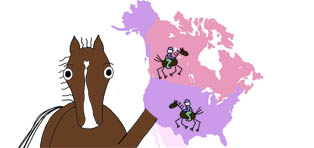March 30,2011
 photo: Juleen Feazell and Sixes Peppy Lady
photo: Juleen Feazell and Sixes Peppy LadyAt the North American Trail Ride Conference, NATRC 2010 National convention in Nashville Tenn., Brandy Ferganchick of Eckert and her Norwegian fjord Fawn Creek Thor (aka: Dodger) received the high average horse-grand champion award.
This award is the total of the average scores of the horse compared with the winner's score at each of nine rides for the whole year.
It is one of the top awards for the nation and was an amazing win as Norwegian fjords are not normally considered distance riding animals.
 photo: Judy Mason and Cedar Mesa Rushai
photo: Judy Mason and Cedar Mesa RushaiNorwegian fjords are small horses from the mountainous regions of Norway where they are used as a light draft and farm work horse. Dodger also received a national championship (accumulation of necessary points and wins in a region).
Brandy was second in the nation for open lightweight horsemanship, and Dodger was second in the nation for open lightweight horse. Brandy and Dodger also received the high point, open, lightweight regional team, horse and rider award.
Juleen Feazell of Cedaredge and her horse Sixes Peppy Lady (aka: Cookie) a lovely paint mare, won the novice, lightweight, regional team award for this region which includes Colorado, New Mexico, Utah and Wyoming.
Judy Mason of Cedar Mesa also received a national championship and third place light weight regional open team awards on her home bred and raised Cedar Mesa Rushai, a charming grey Arabian.
 photo: Brandy Ferganchick and Fawn Creek Thor
photo: Brandy Ferganchick and Fawn Creek ThorAt the regional convention in Pueblo, Brandy and Dodger also won the region's high average horsemanship award, as well as first place open lightweight horse and first place open rider in the region.
Juleen won the high point novice horse and high point novice lightweight horsemanship awards, as well as the regional novice team award.
NATRC encourages the selection, training, riding and care of horses for long distance trail riding. The competitions are typically two days long over well marked and beautiful trails.
Novice riders cover a total distance of about 40 miles in two days at about four mph. Open riders travel 50 to 60 miles at 5 to six mph. The riders are in camp each evening for judging and map briefing for the next day's ride. Horses are judged in camp and on the trail by a veterinarian judge for condition, soundness, and manners. Riders are judged by approved horsemanship judges on balance, position, care of horse on trail, and in camp and safety.
There is a clinic for competitive trail riding on April 30. Brandy, Juleen, Judy, and others will be coaching. For information and reservations contact Mason at 856-7022 or masonranch@aol.com.




 America's wild horses have long been praised by their owners for their toughness, intelligence and endurance.
America's wild horses have long been praised by their owners for their toughness, intelligence and endurance. Sir Kai, currently ridden by Lincoln's Ray Bailey, also was originally adopted by Dr. Ottinger. Bailey acquired the titled three-year-old from Dr. Ottinger in 1997. Sir Kai placed ninth in his first limited-distance ride, the "Death Valley 25," in 1999. He followed that performance with a third place and best condition award in the Lake Oroville Vista LD ride. During the 2003 AERC National Championship Ride, Sir Kai and Bailey placed first in the heavyweight division of the 50-mile ride.
Sir Kai, currently ridden by Lincoln's Ray Bailey, also was originally adopted by Dr. Ottinger. Bailey acquired the titled three-year-old from Dr. Ottinger in 1997. Sir Kai placed ninth in his first limited-distance ride, the "Death Valley 25," in 1999. He followed that performance with a third place and best condition award in the Lake Oroville Vista LD ride. During the 2003 AERC National Championship Ride, Sir Kai and Bailey placed first in the heavyweight division of the 50-mile ride.